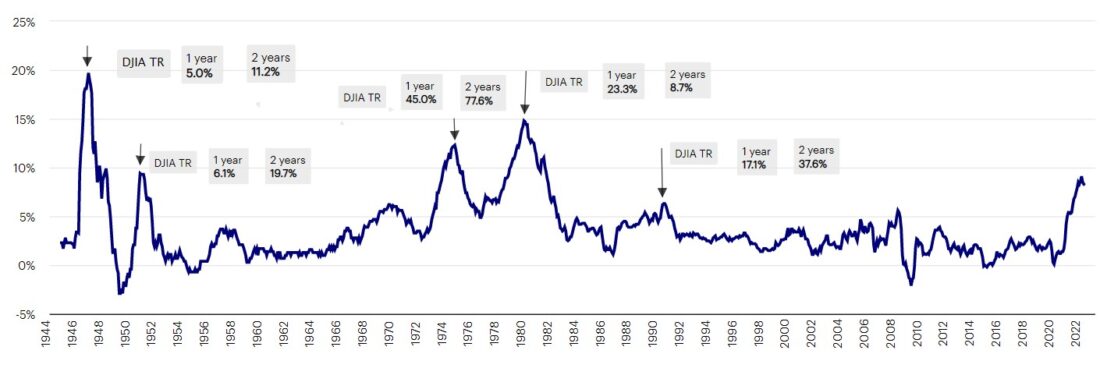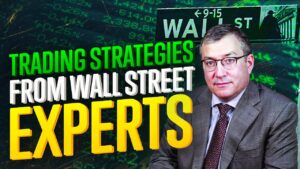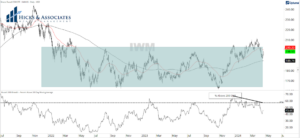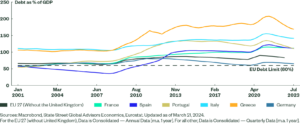Key takeaways
Midterms and markets
- Investors tend to believe that election outcomes matter significantly for the economy and markets, but the data suggests otherwise.
Fed watch
- Inflation has been coming down, but not at a pace that’s sufficient to appease the Federal Reserve (Fed).
Heading for recession?
- High inflation and policy tightening tend to end cycles. It appears a recession is likely in the offing.
Welcome back to Above the Noise. I hadn’t intended to launch a new monthly commentary during an “everything bear” market, but my timing proved impeccable. A broad selloff across most asset classes is not ideal for the retirement accounts and college savings plans, but I’m told readership tends to be higher during the more uncertain times. I struggle to identify when times weren’t uncertain, but I recognize the confluence of factors weighing on investors’ minds. That’s why we’re here. I cover a lot of ground this month, but in the background of it all is an increasingly loud question: Will the Federal Reserve pivot before markets panic? Let’s again try to rise above the noise and put all of this into perspective.
A ‘keep it simple’ strategy
1. Where are we in the cycle?
The job market is still too strong. The economy created 263,000 jobs in September.1 Inflation is still too hot. September’s core inflation reading was 6.6% over the prior year.2 High inflation and policy tightening tend to end cycles. A recession is likely in the offing.
2. What’s the direction of the economy?
It’s a contraction. Financial conditions are tightening, and leading indicators suggest that the economy will be growing below trend and falling.
3. What will be the likely policy response?
(Sigh) Still tighter. The market, prior to the September inflation report, had priced a terminal federal funds rate of roughly 4.5%. That is now closer to 5%.3
With the risk of sounding like a broken record, the conclusion is the same from last month. From a tactically minded perspective, I still favor a more modest risk profile and a more defensive posture in the near-term. This includes quality bonds and businesses that can potentially generate cash flow and growth in a slowing environment. We won’t be in contraction forever, and I look forward to reporting signs of a recovery when we see them.
The national conversation
It’s midterm election time! Nate Silver has said that “Midterm elections can be dreadfully boring, unfortunately.” Not this time. This year’s midterm election participation is projected to reach record levels, resembling counts reached in presidential elections.
As James Carville said in the early 1990s, “It’s the economy, stupid.” That’s still true today — 80% of Americans listed inflation as the most important issue going into the midterms.4
How do we know which party to blame for inflation? There’s a case to be made either way:
The left’s argument: President Trump injected $4 trillion into the economy and pressured his Fed Chair to keep rates low. Plus, inflation isn’t just a US phenomenon. It’s happening everywhere.
The right’s argument: President Biden spent an additional $2 trillion when the economy was already recovering. Gasoline and food prices have skyrocketed under his watch.
Right or wrong, I expect the buck will likely stop with the current president and his party. Midterm elections have been notoriously bad for the party in power anyway.
Does it matter? Investors tend to believe that election outcomes matter significantly for the economy and markets. The data suggests otherwise.
For what it’s worth, here’s the median quarterly real gross domestic product (GDP) under different compositions of government back to 1946:5
- Single-party Republican: 3.6%
- Single-party Democrat: 4.4%
- Divided government: 3.7%
Nothing to see here.
It was said
“(the rapid pace of interest rate hikes to control inflation) is not stepping on the brakes, this is slamming the brakes. The economy is starting to go through the windshield, the financial system is starting to go through the windshield.”6 – Mohamed El-Erian, Chief Economic Advisor at Alliance
“Policymakers are facing a trilemma. They need to fight inflation, support growth, and prevent a financial crisis.”7 – Jonathan Ferro, Co-host Bloomberg Surveillance
Therein lies the rub. Inflation has been coming down, but not at a pace that’s sufficient to appease the Fed. Tightening continues. As the saying goes, “something always breaks when yields rise.”
- April 1990: Nikkei Crash / Savings and Loan Crisis
- November 1994: Mexican Peso Crisis
- August 1996: Asian Currency Crisis
- January 2000: NASDAQ Crash
- May 2006: Housing Crisis
- May 2010: European Debt Crisis
- December 2013: Turmoil in Emerging Markets
- 2022: The “Everything Bear” Market
Investors are now left waiting for the proverbial pause in tightening by the Fed. Will it come because inflation has come down or will it come because something breaks? Pivot or panic? Those are two very different outcomes for the financial markets.
Maybe it’s confirmation bias …
… but every time inflation peaks, it seems to come down rapidly and equities have historically performed well over the subsequent two years.
Equity performance post-peak inflation
US Consumer Price Index and the 1-year and 2-year cumulative returns of the Dow Jones Industrial Average Total Return (DJIA TR) Index post peak inflation above 6%

Source: Bloomberg, US Bureau of Labor Statistics, 9/30/22. Inflation peaks: March 1947, April 1951, December 1974, May 1980, and November 1990. he Dow Jones Industrial Average is a stock market index of 30 prominent companies listed on stock exchanges in the United States. Indices cannot be purchased directly by investors. Past performance is no guarantee of future results.
On the road again
My travels this month took me to Minneapolis for the annual Financial Planning Association conference. The topic was The Great Economic Debate, and the participants were David Kelly of J.P. Morgan, Jim Paulsen of The Leuthold Group, and me. I’ll be honest, 20-year-old Brian Levitt would not have expected to be on that stage.
Let’s just say that our views were largely congruent. So much for a debate. A highlight of the session for me was when Jim Paulsen rose to present after I had concluded and said, “Ditto.” The crowd got a laugh out of that. I couldn’t help but think of General George Patton and his famous quip, “If everyone is thinking alike then somebody isn’t thinking.” That point wasn’t lost on all three of us.
All of us shared the opinion that:
- The war against inflation will be coming to an end.
- The Fed will ultimately go too far. Today’s inflation isn’t structural. Kelly asked why is the Fed data dependent? Don’t they have models to assess the future? If the three of us see the problems of tightening into a global contraction, why don’t they? Great questions.
- A recession is likely, and the risk of an accident is heightened. The Fed will then pivot.
- Valuations, in equities and fixed income, are becoming quite attractive. As my first chart showed, markets have tended to do well after inflation has peaked, even in the event of recessions.
I’m already looking forward to next year’s event. David – if you’re reading this, I want to know more about you sending a hologram of yourself to Las Vegas to present to clients. Neat. Was the hologram able to enjoy Vegas’s great restaurant and club scenes? Asking for a friend.
Since you asked
Could inflation really possibly fall below 4% within the next year? How and by when? With reverence to Chevy Chase’s classic character Irwin M. “Fletch” Fletcher, “Come on guys, it’s so simple. Maybe you need a refresher course. It’s all (mathematics) nowadays.”
Fortunately, this math could be easier than figuring out Underhill’s tab. Let’s assume a 0.3% monthly inflation rate over the next year. Why 0.3%? That’s about half the average monthly inflation rate in the first nine months of 2022.8 Also, remember that inflation was flat in July, was up 0.1% in August, and was up 0.4% in September, for an average of 0.26%.9
We run it through the Excel machine:
Doing the math: Inflation assumptions
September 2021 to September 2022 are actual inflation figures. Starting with October 2022, we do the math to show what 0.3% monthly increases in CPI would look like over the next nine months.
| Date | Consumer Price Index Level | Consumer Price Index Year over Year Percent Change |
|---|---|---|
| Sep. 2021 | 274.21 | 5.4% |
| Oct. 2021 | 276.59 | 6.2% |
| Nov. 2021 | 278.52 | 6.8% |
| Dec. 2021 | 280.13 | 7.0% |
| Jan. 2022 | 281.93 | 7.5% |
| Feb. 2022 | 284.18 | 7.9% |
| Mar. 2022 | 287.71 | 8.5% |
| Apr. 2022 | 288.66 | 8.3% |
| May 2022 | 291.47 | 8.6% |
| Jun. 2022 | 295.33 | 9.1% |
| Jul. 2022 | 295.27 | 8.5% |
| Aug. 2022 | 295.62 | 8.3% |
| Sep. 2022 | 296.76 | 8.2% |
| Oct. 2022 | (296.76*1.003) = 297.65 | ((297.65/276.59) – 1) = 7.6% |
| Nov. 2022 | (297.76*1.003) = 298.54 | ((298.54/278.52) – 1) = 7.2% |
| Dec. 2022 | (298.54*1.003) = 299.43 | ((299.43/280.13) – 1) = 6.9% |
| Jan. 2023 | (299.43*1.003) = 300.33 | ((300.33/281.93) – 1) = 6.5% |
| Feb. 2024 | (300.33*1.003) = 301.23 | ((301.23/284.18) – 1) = 6.0% |
| Mar. 2024 | (301.23*1.003) = 302.14 | ((302.14/287.71) – 1) = 5.0% |
| Apr. 2024 | (302.14*1.003) = 303.05 | ((303.05/288.66) – 1) = 4.9% |
| May 2024 | (303.05*1.003) = 303.96 | ((303.96/291.47) – 1) = 4.3% |
| Jun. 2024 | (303.96*1.003) = 304.87 | ((304.87/295.33) – 1) = 3.2% |
Source: US Bureau of Labor Statistics, 9/30/22. For illustrative purposes only and not intended as investment advice or as a forecast.
Annual inflation down to 3.2% by June? If you assume a 0.3% monthly increase, then yes. See kids, math is fun.
Everyone has a podcast
The latest two episodes of the Greater Possibilities podcast feature Rob Waldner, Chief Strategist for Invesco Fixed Income, and Andy Blocker, Global Head of Public Policy. If you want views on the bond market and the midterm election, respectively (and judging by your questions, you do) then these are worth a listen.
My takeaways from Rob:
- The time to protect your portfolio from inflation is over. Instead, the question is how to protect your portfolio from the Fed.
- There’s now finally value in the fixed income markets.
- Higher quality corporate bonds are finally offering attractive yields. If we get a dovish Fed pivot, Rob believes that should be a good entry point. If there’s a recession, Rob says spreads would widen but a default wave would be unlikely. The duration component would likely help to offset some of the spread widening.
My takeaways from Andy:
- Inflation is still front and center in voters’ minds. The party in power tends to lose seats in the midterms, plain and simple. The highest probability outcome is a divided government with the Democrats losing the House and potentially the Senate.
- The recent outbreak of bipartisan legislation was made possible by Americans pushing for safer communities, better roads, reasonable prescription drug costs, modern manufacturing, US competitiveness globally. In short, politicians believed the consequences of inaction outweighed the potential pushback against action.
- Don’t expect bipartisanship to continue. If the Republicans win the House, we are likely to find ourselves in a contentious environment, rendering the passage of significant legislation unlikely.
Song of the month
Let’s go with “Wake Me Up When September Ends” by Green Day. The challenging market of September carried into the early days of October. I was afraid we would regret waking up Green Day. Yet, as we go to print, the S&P 500 Index appears to be poised for a positive-return month. It may prove to be little more than a near-term bounce as challenges remain. Nonetheless, I do expect a recovery to play out in 2023. Investors should be awake and alert looking for signs of recovery and arising investment opportunities.
Footnotes
- 1Source: US Bureau of Labor Statistics, 9/30/22.
- 2Source: US Bureau of Labor Statistics, 9/30/22.
- 3Source: Bloomberg, 10/13/22. As represented by the Fed Funds Implied Futures.
- 4Source: Pew Research Center, 6/30/22. Latest data available.
- 5Source: US Bureau of Economic Analysis, 6/30/22.
- 6Source: Bloomberg News, “El-Erian Says Economy Is Starting to ‘Go Through the Windshield,’” 10/11/22
- 7Source: Bloomberg Surveillance
- 8Source: US Bureau of Labor Statistics, 9/30/22. The average monthly gain in the Consumer Price Index for the first nine months of the year is 0.63%.
- 9Source: US Bureau of Labor Statistics, 9/30/22.
—
Originally Posted October 26, 2022
Above the Noise: Pivot or panic? by Invesco US
Important information
NA2518766
This does not constitute a recommendation of any investment strategy or product for a particular investor. Investors should consult a financial professional before making any investment decisions.
All investing involves risk, including the risk of loss.
Past performance does not guarantee future results.
Investments cannot be made directly in an index.
In general, stock values fluctuate, sometimes widely, in response to activities specific to the company as well as general market, economic and political conditions.
Fixed-income investments are subject to credit risk of the issuer and the effects of changing interest rates. Interest rate risk refers to the risk that bond prices generally fall as interest rates rise and vice versa. An issuer may be unable to meet interest and/or principal payments, thereby causing its instruments to decrease in value and lowering the issuer’s credit rating.
The Consumer Price Index (CPI) measures change in consumer prices as determined by the US Bureau of Labor Statistics.
Core inflation excludes food and energy prices
Tightening is a monetary policy used by central banks to normalize balance sheets.
Gross Domestic Product (GDP) is the total value of goods and services produced in a year.
The federal funds rate (or fed funds rate) is the rate at which banks lend balances to each other overnight.
The terminal rate is the anticipated level that the federal funds rate will reach before the Federal Reserve stops its tightening policy.
Yield spread is the difference between yields on differing debt instruments, calculated by deducting the yield of one instrument from another.
Duration is a measure of the sensitivity of the price (the value of principal) of a fixed income investment to a change in interest rates. Duration is expressed as a number of years.
The opinions referenced above are those of the author as of Oct. 24, 2022. These comments should not be construed as recommendations, but as an illustration of broader themes. Forward-looking statements are not guarantees of future results. They involve risks, uncertainties and assumptions; there can be no assurance that actual results will not differ materially from expectations.
Disclosure: Invesco US
This does not constitute a recommendation of any investment strategy or product for a particular investor. Investors should consult a financial advisor/financial consultant before making any investment decisions. Invesco does not provide tax advice. The tax information contained herein is general and is not exhaustive by nature. Federal and state tax laws are complex and constantly changing. Investors should always consult their own legal or tax professional for information concerning their individual situation. The opinions expressed are those of the authors, are based on current market conditions and are subject to change without notice. These opinions may differ from those of other Invesco investment professionals.
NOT FDIC INSURED
MAY LOSE VALUE
NO BANK GUARANTEE
All data provided by Invesco unless otherwise noted.
Invesco Distributors, Inc. is the US distributor for Invesco Ltd.’s Retail Products and Collective Trust Funds. Institutional Separate Accounts and Separately Managed Accounts are offered by affiliated investment advisers, which provide investment advisory services and do not sell securities. These firms, like Invesco Distributors, Inc., are indirect, wholly owned subsidiaries of Invesco Ltd.
©2024 Invesco Ltd. All rights reserved.
Disclosure: Interactive Brokers
Information posted on IBKR Campus that is provided by third-parties does NOT constitute a recommendation that you should contract for the services of that third party. Third-party participants who contribute to IBKR Campus are independent of Interactive Brokers and Interactive Brokers does not make any representations or warranties concerning the services offered, their past or future performance, or the accuracy of the information provided by the third party. Past performance is no guarantee of future results.
This material is from Invesco US and is being posted with its permission. The views expressed in this material are solely those of the author and/or Invesco US and Interactive Brokers is not endorsing or recommending any investment or trading discussed in the material. This material is not and should not be construed as an offer to buy or sell any security. It should not be construed as research or investment advice or a recommendation to buy, sell or hold any security or commodity. This material does not and is not intended to take into account the particular financial conditions, investment objectives or requirements of individual customers. Before acting on this material, you should consider whether it is suitable for your particular circumstances and, as necessary, seek professional advice.












![[Gamma] Scalping Please [Gamma] Scalping Please](https://ibkrcampus.com/wp-content/smush-webp/2024/04/tir-featured-8-700x394.jpg.webp)
![[Gamma] Scalping Please [Gamma] Scalping Please](https://ibkrcampus.com/wp-content/uploads/2024/04/tir-featured-8-700x394.jpg)













![[Gamma] Scalping Please [Gamma] Scalping Please](https://ibkrcampus.com/wp-content/smush-webp/2024/04/tir-featured-8-300x169.jpg.webp)
![[Gamma] Scalping Please [Gamma] Scalping Please](https://ibkrcampus.com/wp-content/uploads/2024/04/tir-featured-8-300x169.jpg)